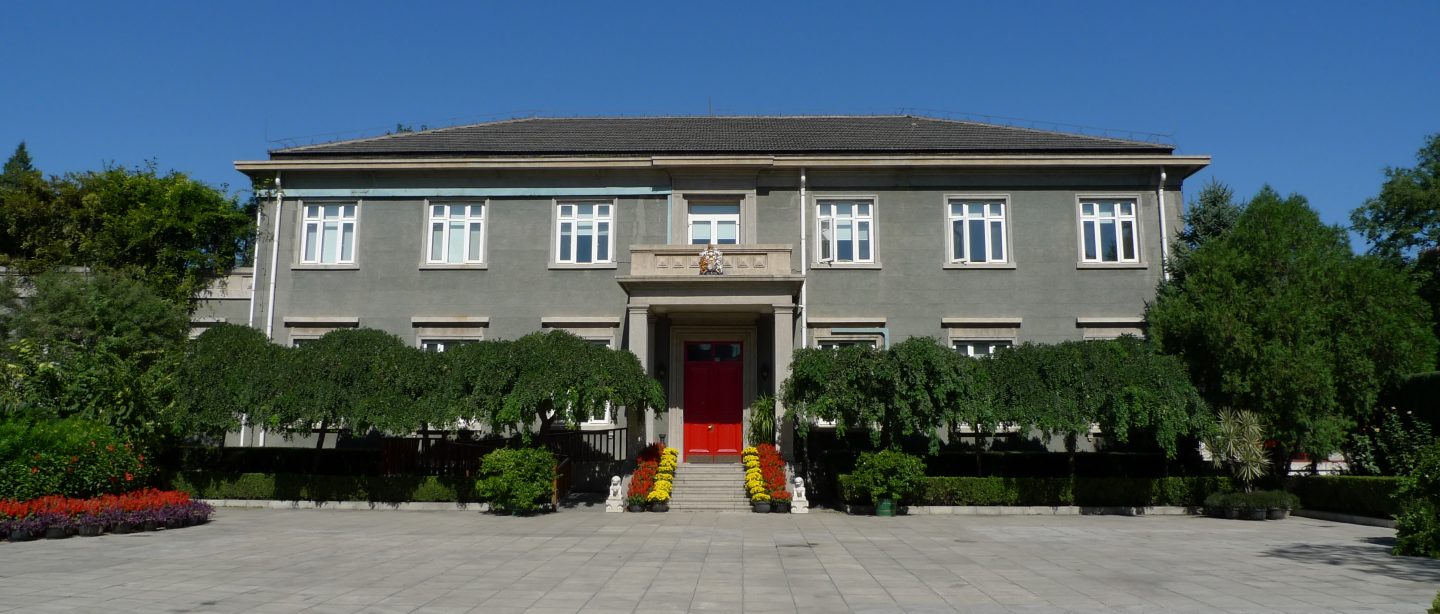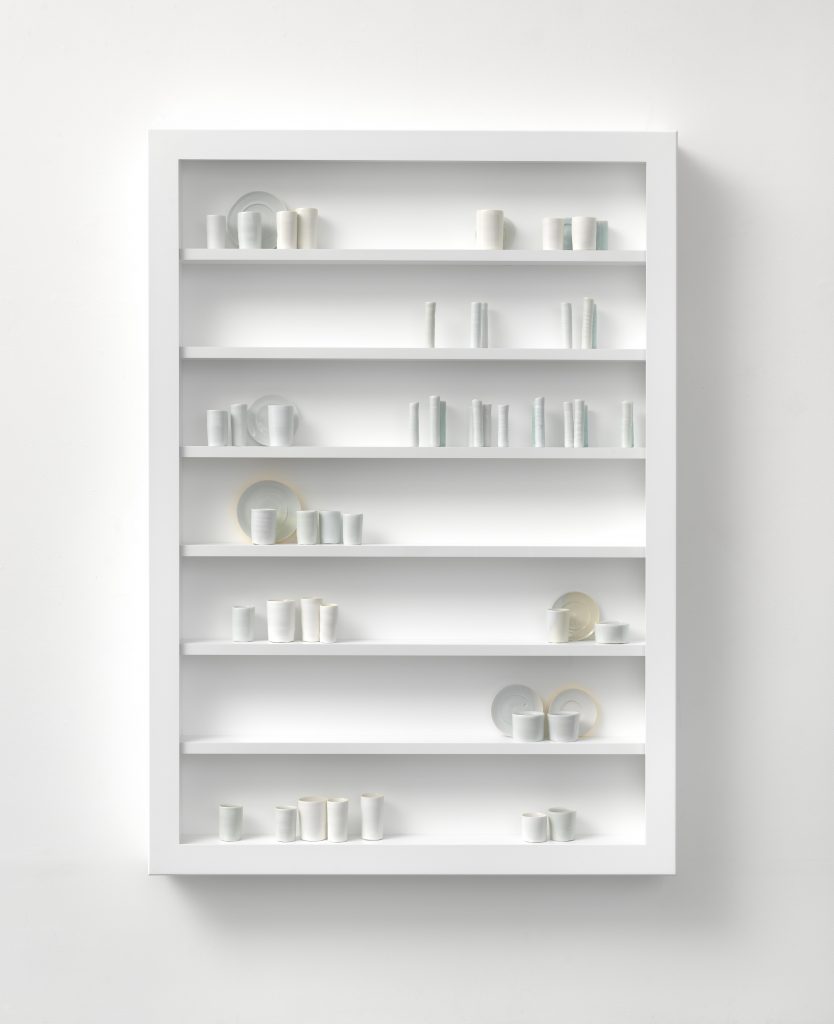How to make an entrance: rock, paper, scissors?
First impressions count. The contemporary art at the British Ambassador's Residence in Beijing is a conversation starter, often illuminating the connections between Britain and China. The art portrays a modern, sustainable and innovative Britain, underlining historical and contemporary links to events and individuals, that are of significance for both nations.

Exterior of the British Ambassador's Residence, Beijing © Crown Copyright
Rock - Paper - Scissors by British artist, Ceal Floyer
How many visitors stepping into the British Ambassador’s Residence in Beijing would guess that ‘Rock paper scissors’ originated in China? Played by children and adults around the world, this universal game is based on a hierarchy in which two people try to outwit each other by demonstrating the more ‘powerful’ hand sign over the other, representing a rock, paper or a pair of scissors.
This well-known game is the focus of Rock – Paper – Scissors, a work by British artist, Ceal Floyer. Made in 2013, the work presents each object separately as a line of photographs. Floyer works across film, installation and sculpture, and often shows everyday objects in a new light, playfully inviting us to think about how sight, reality and language can slip and slide around.
Ceal Floyer, Rock-Paper-Scissors, 2013 / © DACS 2016
Challenging us to look at familiar objects from a different perspective is a subtle but powerful role that the Collection artworks play in the Residence. Floyer’s piece is one of three contemporary works that visitors encounter as soon as they walk into the entrance hall. Strategically placed, these works make a vivid first impression, while amplifying the business of diplomatic dialogue that happens inside the building.
No Moon Shining by British artist Isaac Julien
One of the works displayed nearby Floyer’s work is No Moon Shining, a large-scale photograph by British artist Isaac Julien. The photograph relates to Ten Thousand Waves, a film installation produced by the artist in 2010. Mournful and poetic, the film weaves together stories linking China’s ancient past to a recent event involving a group of Chinese men and women in Lancashire, UK. Played out across nine screens, the film is a meditation on unfinished journeys, the passage of people across continents and on the spiritual displacement of ‘lost souls’, a belief that resonates in Chinese culture. Filmed on location in the remote Guangxi province and in sites around Shanghai, the original inspiration for the film was closer to home.
Isaac Julien, No Moon Shining, 2010 /Courtesy of the Artist and Victoria Miro, London © Isaac Julien
On 5 February 2004, 23 Chinese men and women, employed illegally as cockle-pickers in the UK, drowned under darkness in the incoming tide at Morecambe Bay, Lancashire. Only one man survived. Undocumented, the workers’ identity remained unknown except that they were believed to have left homes in Fujian Province. The contemporary Chinese poet, Wang Ping, composed his poem Ten Thousand Waves in remembrance of the anonymous dead.
Inspired in turn by the poem, Julien invited and commissioned Wang Ping to collaborate with him on a script to accompany this artist’s film. The film references The Tale of Yishan Island, a contemporary Chinese story in which fishermen lost at sea are led to safety by a goddess. No Moon Shining presents a landscape of extraordinary beauty emerging from low-lying mist, and a scene that echoes the voices of the dead longing for home as imagined by the poet:
On the night of the Lantern Festival
We stream into the sea
Jumbos, tiernels
Three-forked prongs
The wind bites our ears, hands, and toes
Home, we say, home
A short history of the China trade, a sculpture by Edmund De Waal
Cultural and historical links between Britain and China are explored with radical elegance in A Short History of the China Trade, a sculpture by Edmund de Waal commissioned by the Government Art Collection for display at the Residence.
Edmund de Waal, A Short History of the China Trade, 2016. Commissioned with the generous support of Rosamund Brown in memory of her husband, Charles H Brown; The Rothschild Foundation; The Sackler Trust and with assistance from Madeleine Bessborough, New Art Centre; © Edmund de Waal; image © Mike Bruce, courtesy of Edmund de Waal
Described by the artist and author as a deliberate but ‘…quiet nod to the generative, generous relationship between the UK and China’, De Waal’s work takes the relationship that both countries have had with porcelain, as its subject. Inside a glass vitrine, groups of hand-thrown porcelain vessels sit on white shelves. Widely recognised for his own work with this fine ceramic material, De Waal describes this sculpture as:
…a very personal mapping of the thousand years of porcelain trade – the way in which China reached the rest of the world… It includes many celadons – the very beautiful blue-green glazes that epitomise Chinese porcelain. Here is the celadon of Marco Polo’s vase in Venice – the first piece to arrive in the West – the colours of deep Imperial stem-cups. Here are all the whites – the whites of vessels for Buddhist ritual, the aspirational colours that Europe couldn’t get and strived for, until they broke the secrets of the Arcanum. There is gold here too. Both porcelain as ‘white gold’, the most precious of materials, and also on the broken shards of a vessel, referencing the way in which gold is used to mend broken porcelain in China and Japan.
Made from clay originating from China since the Han dynasty, porcelain has over generations, created a bridge of deep cultural and economic significance between Britain and China. Enjoyed and viewed by the many thousands of visitors to the Residence each year, A Short History of the China Trade occupies a space that is as de Waal has said: ‘… on the threshold of where people come and depart. This piece is above all about the ebb and flow of trade, of ideas, of objects, of beliefs, and of images’.
Edmund de Waal talks about his commission for the Government Art Collection
Written by Chantal Condron, Curator (Public Engagement and Research)


